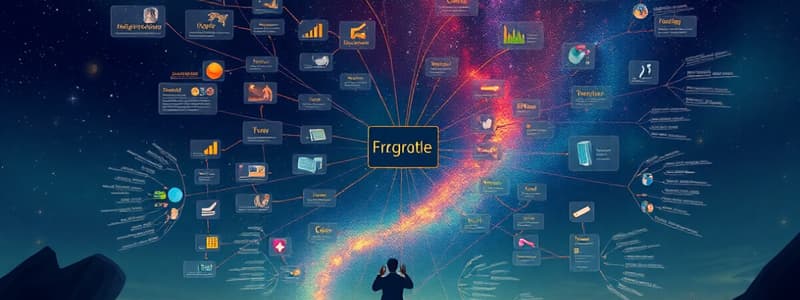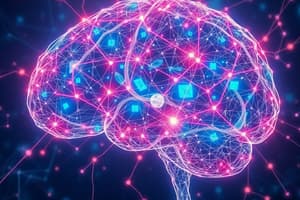Podcast
Questions and Answers
Which of the following is NOT a recommended practice in modern mind mapping, according to Tony Buzan's rules?
Which of the following is NOT a recommended practice in modern mind mapping, according to Tony Buzan's rules?
- Employing a central image to represent the main topic.
- Allocating space for unexpected ideas that may emerge during the process.
- Using multiple keywords per line to capture detailed information. (correct)
- Utilizing at least three different colours to enhance visual appeal and organization.
How do mind maps facilitate project management, particularly in team discussions?
How do mind maps facilitate project management, particularly in team discussions?
- By enforcing a linear, step-by-step approach to project tasks.
- By automatically generating project timelines and schedules.
- By providing a visual representation that integrates ideas around a central issue. (correct)
- By limiting the number of team members who can contribute ideas.
In project management, how can mind mapping software enhance the traditional whiteboard approach?
In project management, how can mind mapping software enhance the traditional whiteboard approach?
- By restricting brainstorming sessions to pre-approved ideas.
- By enforcing a rigid, unchangeable project structure.
- By eliminating the need for team discussions.
- By automatically converting mind maps into Work Breakdown Structures (WBS). (correct)
How do mind maps assist in decomposing project work packages into tasks?
How do mind maps assist in decomposing project work packages into tasks?
What is the primary use of mind mapping in Waterfall projects?
What is the primary use of mind mapping in Waterfall projects?
What characteristic defines the use of mind mapping in Agile projects?
What characteristic defines the use of mind mapping in Agile projects?
How does the level of detail in a mind map differ between Waterfall and Agile projects?
How does the level of detail in a mind map differ between Waterfall and Agile projects?
In which project methodology is the flexibility of a mind map considered dynamic and adaptable, changing as new information arises?
In which project methodology is the flexibility of a mind map considered dynamic and adaptable, changing as new information arises?
How does task decomposition differ between Waterfall and Agile projects when using mind maps?
How does task decomposition differ between Waterfall and Agile projects when using mind maps?
How are task dependencies managed differently in Waterfall versus Agile projects using mind maps?
How are task dependencies managed differently in Waterfall versus Agile projects using mind maps?
How do scope changes affect mind maps in Waterfall versus Agile projects?
How do scope changes affect mind maps in Waterfall versus Agile projects?
How does collaboration during mind map creation differ in Waterfall versus Agile projects?
How does collaboration during mind map creation differ in Waterfall versus Agile projects?
How does the use of mind maps for creating a WBS differ between Waterfall and Agile projects?
How does the use of mind maps for creating a WBS differ between Waterfall and Agile projects?
Which of the following project management activities is best supported by the use of mind mapping?
Which of the following project management activities is best supported by the use of mind mapping?
What is the most significant advantage of using mind mapping software over traditional methods like whiteboards, particularly for larger projects?
What is the most significant advantage of using mind mapping software over traditional methods like whiteboards, particularly for larger projects?
Which of the following factors most influences the effectiveness of mind mapping in a team environment?
Which of the following factors most influences the effectiveness of mind mapping in a team environment?
In the context of project planning, how does using colors in mind mapping contribute to its effectiveness?
In the context of project planning, how does using colors in mind mapping contribute to its effectiveness?
Considering the differences in project management approaches, when would a project manager MOST likely opt to use a mind mapping tool instead of a Gantt chart?
Considering the differences in project management approaches, when would a project manager MOST likely opt to use a mind mapping tool instead of a Gantt chart?
What potential risk is MOST associated with relying heavily on mind mapping without integrating it with other project management tools?
What potential risk is MOST associated with relying heavily on mind mapping without integrating it with other project management tools?
Which scenario best illustrates the effective use of mind mapping in resolving a complex project issue?
Which scenario best illustrates the effective use of mind mapping in resolving a complex project issue?
Flashcards
Mind Mapping
Mind Mapping
A visual tool used for organizing information around a central topic, with branches representing related ideas and subtopics.
Tony Buzan
Tony Buzan
Psychologist who formalized mind mapping with specific rules, including using a central image and one keyword per line.
Purpose of Mind Mapping in Waterfall
Purpose of Mind Mapping in Waterfall
Initial planning and project breakdown.
Purpose of Mind Mapping in Agile
Purpose of Mind Mapping in Agile
Signup and view all the flashcards
Usage Timing in Waterfall
Usage Timing in Waterfall
Signup and view all the flashcards
Usage Timing in Agile
Usage Timing in Agile
Signup and view all the flashcards
Project Flow in Waterfall
Project Flow in Waterfall
Signup and view all the flashcards
Project Flow in Agile
Project Flow in Agile
Signup and view all the flashcards
Level of Detail in Waterfall
Level of Detail in Waterfall
Signup and view all the flashcards
Level of Detail in Agile
Level of Detail in Agile
Signup and view all the flashcards
Work Breakdown Structure (WBS)
Work Breakdown Structure (WBS)
Signup and view all the flashcards
Flexibility in Waterfall
Flexibility in Waterfall
Signup and view all the flashcards
Flexibility in Agile
Flexibility in Agile
Signup and view all the flashcards
Task Decomposition in Waterfall
Task Decomposition in Waterfall
Signup and view all the flashcards
Task Decomposition in Agile
Task Decomposition in Agile
Signup and view all the flashcards
Dependencies in Waterfall
Dependencies in Waterfall
Signup and view all the flashcards
Dependencies in Agile
Dependencies in Agile
Signup and view all the flashcards
Scope Changes in Waterfall
Scope Changes in Waterfall
Signup and view all the flashcards
Scope Changes in Agile
Scope Changes in Agile
Signup and view all the flashcards
Collaboration in Waterfall
Collaboration in Waterfall
Signup and view all the flashcards
Study Notes
- Mind mapping's origins can be traced back centuries, with Leonardo DaVinci being cited as a key historical figure, followed by Charles Darwin, Thomas Edison, and Albert Einstein.
- Tony Buzan, a British psychologist, formalized the modern approach to mind mapping.
- Buzan's rules include using a central image, dedicating a branch to each topic, using sub-branches for sub-topics, employing at least three colors, limiting each line to a single keyword, and leaving room for unexpected ideas.
- Project managers utilize mind mapping for its graphic capabilities and ease of team discussion.
- Mind mapping involves visualizing a problem and integrating related ideas by drawing subtopics around a central issue.
- Whiteboards are sufficient for simple projects, but mind mapping software is recommended for complex projects.
- Certain software can automatically transform a mind map into a Work Breakdown Structure (WBS) for scheduling purposes.
- Mind maps are useful for breaking down project work packages into tasks through team discussions.
- They provide a system-wide view of a project (central hub), with work packages as branches and tasks within those packages as sub-branches.
Waterfall Projects
- Used for initial planning and project breakdown.
- Primarily used at the beginning of the project.
- Follows a linear and sequential flow.
- Provides a detailed breakdown of work packages and tasks.
- Static and rigid once created.
- Decomposes tasks based on project phases.
- Dependencies between tasks are clearly defined.
- Scope changes are limited.
- Collaboration mainly occurs during initial planning.
- Mind maps can be converted into a WBS for scheduling tools.
Agile Projects
- Used for continuous refinement and backlog management.
- Used throughout the project, with updates in each sprint.
- Follows an iterative and incremental flow.
- Focuses on high-level tasks refined over time (user stories, features).
- Dynamic and adaptable to new information or requirements.
- Decomposes tasks based on user stories or features for each sprint.
- Task dependencies are flexible and change with each sprint.
- Frequent scope changes are accommodated.
- Ongoing collaboration with regular updates during sprint planning, reviews, and retrospectives.
- Mind maps evolve into backlog refinement and sprint planning.
Studying That Suits You
Use AI to generate personalized quizzes and flashcards to suit your learning preferences.




